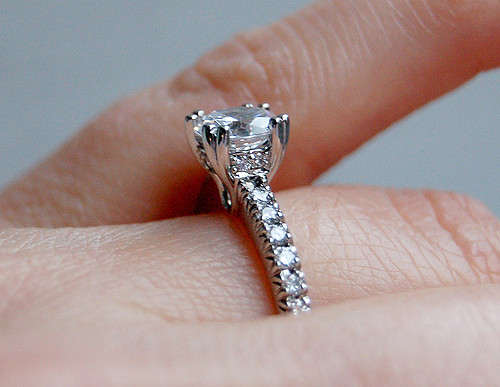Wedding engagement vocabulary Posted by Gabriele on May 31, 2016 in Culture, English Vocabulary
We are approaching “wedding season” in the United States. Wedding season is a term used to describe the time of year, the summer months, in which most weddings in the United States take place. June is the most popular month for American’s to get married (10.2% of wedding happen in June), but July and August are also popular months to get married. The reason for this is likely because the weather is best for a wedding this time of year, people can travel easier to weddings when the weather is good, and they are more likely to take time off from work to attend an out-of-town wedding.
Because we are approaching wedding season I wanted to share with you some vocabulary related to wedding engagements – the period of time before a couple gets married. If you want to find some vocabulary specific to weddings themselves take a look at these two posts: American Wedding Traditions and An American Wedding
Wedding engagement vocabulary:
to pop the question = to ask someone to marry you
Example: John popped the question last night and I said yes!
to get down on one knee = to ask someone to marry you
Example: I took Jill to a romantic dinner, then I got down on one knee, and she said ‘yes.’
engagement ring – This is a ring given by one partner (usually the man) to the other partner (usually the women) as a promise of marriage. Engagement rings usually have a diamonds or other gemstones on them. They are commonly worn on the ring finger of the left hand. When a couple gets married, they exchange ‘wedding bands’, which tends to be more simple rings.
engagement party – This is a party to celebrate a couple’s recent engagement. It offers a chance for future wedding guests to get to know one another and people to share in the excitement of the couple’s engagement. This party can be causal or formal, but it is usually less formal than the actual wedding.
fiancé – This is the name used to refer to the members of a couple who are engaged. Both the man and the women are called ‘fiancé’ once they are engaged. This replaces the words ‘boyfriend’ or ‘girlfriend’ when referring to one’s romantic partner. After marriage the terms ‘husband’ and ‘wife’ are then used.
to make a guest list – The couple who is getting married, and their parents, need to make a wedding guest list of the people they want to invite to the wedding. This is a process that involves some back-and-forth between the couple and their parents so that a list that includes all the important people is created.
wedding registry – This is a list of items the couple who is getting married would like for wedding gifts (for example cookware, towels, sheets, small appliances, etc.). Many stores offer the service of keeping a free wedding registry (a list of gifts that the couple has picked out specifically) that wedding guests can look up (online or in stores) to find out what the couple wants. Couples let their guests know where they are “registered” on their save-the-date or wedding invitation.
save-the-date – This is a card, and often just a post card (or sometimes electronic message), that is sent to guests approximately 6 months before the wedding will take place. This card is sent to let people know when the wedding will be, but it is not a formal invitation. The save-the-date is sent to help guests make travel arrangements and keep the day of the wedding free from other obligations.
To finish off this post I have some interesting statistics for you (from Sound Vision) about American weddings.
– 1/3 of a million couples wed every year in the US
– the average age of a bride in the US is 25.3
– average age of a groom is 26.9
– average number of guests invited to a wedding is 178

Build vocabulary, practice pronunciation, and more with Transparent Language Online. Available anytime, anywhere, on any device.
About the Author: Gabriele
Hi there! I am one of Transparent Language's ESL bloggers. I am a 32-year-old native English speaker who was born and raised in the United States. I am living in Washington, DC now, but I have lived all over the US and also spent many years living and working abroad. I started teaching English as a second language in 2005 after completing a Master's in Applied Linguists and a Certificate in English Language Teaching to Adults' (CELTA). Since that time I have taught ESL in the United States at the community college and university level. I have also gone on to pursue my doctorate in psychology and now I also teach courses in psychology. I like to stay connected to ESL learners around the world through Transparent Languages ESL Blog. Please ask questions and leave comments on the blog and I will be sure to answer them.




